
Karst is a topography formed from the dissolution of soluble carbonate rocks such as limestone, dolomite, and gypsum. It is characterized by features like poljes above and drainage systems with sinkholes and caves underground. More weathering-resistant rocks, such as quartzite, can also occur, given the right conditions.

A wetland is a distinct ecosystem that is flooded or saturated by water, either permanently for years or decades or seasonally for a shorter periods. Flooding results in oxygen-free anoxic processes prevailing, especially in the soils. The primary factor that distinguishes wetlands from terrestrial land forms or water bodies is the characteristic vegetation of aquatic plants, adapted to the unique anoxic hydric soils. Wetlands are considered among the most biologically diverse of all ecosystems, serving as home to a wide range of plant and animal species. Methods for assessing wetland functions, wetland ecological health, and general wetland condition have been developed for many regions of the world. These methods have contributed to wetland conservation partly by raising public awareness of the functions some wetlands provide. Constructed wetlands are designed and built to treat municipal and industrial wastewater as well as to divert stormwater runoff. Constructed wetlands may also play a role in water-sensitive urban design.

A marsh is — according to ecological definitions — a wetland that is dominated by herbaceous rather than woody plant species. More in general, the word can be used for any low-lying and seasonally waterlogged terrain. In Europe and in agricultural literature low-lying meadows that require draining and embanked polderlands are also referred to as marshes or marshland.

Galway Bay is a bay on the west coast of Ireland, between County Galway in the province of Connacht to the north and the Burren in County Clare in the province of Munster to the south; Galway city is on the northeast side. The bay is about 50 kilometres (30 mi) long and from 10 kilometres (6 mi) to 30 kilometres (20 mi) in breadth. The Aran Islands are to the west across the entrance and there are numerous small islands within the bay. To the west of Galway, the rocks are granite but to the south they are limestone.
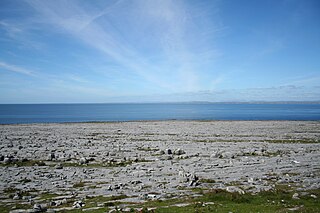
The Burren is a karst/glaciokarst landscape centred in County Clare, on the west coast of Ireland. It measures around 530 square kilometres (200 sq mi), within the circle made by the villages of Lisdoonvarna, Corofin, Gort and Kinvara. The area includes such natural features as Mullaghmore hill and Ailladie cliffs, and historic monuments such as Poulnabrone dolmen and Caherconnell Stone Fort. The Burren National Park covers a small part of the Burren and is the smallest of the six National Parks in Ireland, while the adjacent territory, including the Cliffs of Moher, is included in the Burren and Cliffs of Moher Geopark.
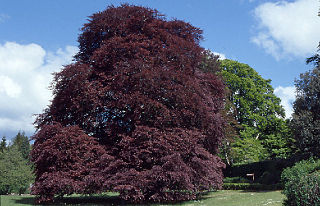
Coole Park is a nature reserve of approximately 1,000 acres (4 km2) located a few miles west of Gort, County Galway, Ireland. It is managed by the Irish National Parks & Wildlife Service, part of the Department of Arts, Heritage and the Gaeltacht. The park is in a low–lying karstic limestone area characterised by seasonal lakes, known as turloughs, which are almost unique to Ireland. It has extensive woodlands. There are 6 kilometres of signposted nature trails plus a formal late 18th century walled garden.

Mushroom stones, or mushroom rocks, in Ireland are limestone boulders undercut by past weathering regimes. These rocks take the form of solitary sentinels of limestone which still bear the unmistakable marks of long-continued erosion by ice, soil or lapping waves at the edge of lakes which have since vanished or retreated. These stones are sometimes shaped like mushrooms, others have an overhang facing in just one direction, but all are notched and undercut in such a fashion as to suggest prolonged exposure to standing water at some time in the past. The mushroom-shaped stones are produced where the notching forms a fairly even circle around the stone.

The Kretschmarr Cave mold beetle is a small mold beetle.
Rahasane turlough is a turlough, west of Craughwell in southwest County Galway. It is the largest surviving turlough in Ireland.
Carmel National Nature Reserve lies close to the village of Carmel in Carmarthenshire. It lies south of Llandeilo not far from the main road to Llanelli. There is a small car park and picnic site for visitors, and footpaths for access. There is an explanatory notice board at the car park. The site is managed by the Wildlife Trust of South and West Wales and Natural Resources Wales (NRW).

Tanymastix stagnalis is a species of Anostraca that lives in temporary pools across Europe. It may reach up to 2 cm (0.8 in) in some areas and has 11 pairs of bristly, flattened appendages. It swims upside-down and filters food particles from the water. It is the only species of Anostraca in Ireland, having been discovered in Rahasane turlough in 1974.

Ireland is in the Atlantic European Province of the Circumboreal Region, a floristic region within the Holarctic.
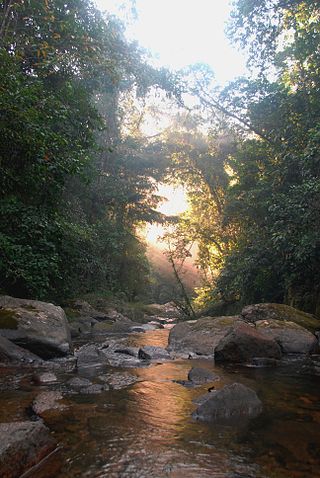
Bladen Nature Reserve in Belize is a landscape of caves, sinkholes, streams and rivers, old growth rainforest and an abundance of highly diverse flora and fauna which includes a great deal of rare and endemic species.

Cernydd Carmel is a Site of Special Scientific Interest in Carmarthenshire, Wales.
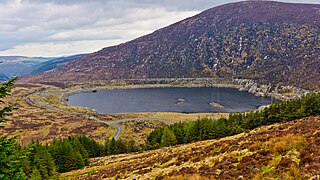
The Turlough Hill Power Station is a pumped storage power station in Ireland, owned and operated by the Electricity Supply Board (ESB).
Callows are a type of wetland found in Ireland. They are a seasonally flooded grassland ecosystem found on low-lying river floodplains.

Lough Funshinagh is a lake and Special Area of Conservation in County Roscommon, Ireland, found to the west of Lough Ree. It has been called Ireland's amazing disappearing lake, due to the way it empties quickly - in as little as two days - and unpredictably, sometimes killing thousands of fish. Lough Funshinagh is one of a number of seasonal lakes, or turlough, found in the karst areas of Ireland, west of the River Shannon.
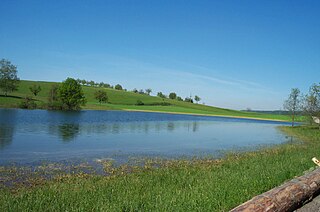
Karst lakes are formed as the result of a collapse of caves, especially in water-soluble rocks such as limestone, gypsum and dolomite. This process is known as karstification. They can cover areas of several hundred square kilometres. Their shallow lakebed is usually an insoluble layer of sediment so that water is impounded, leading to the formation of lakes. Many karst lakes only exist periodically, but return regularly after heavy rainfall.
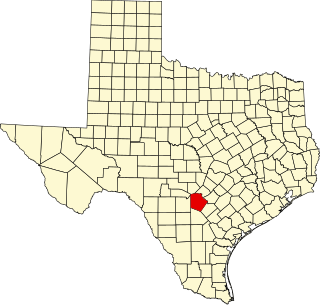
Rhadine infernalis is a species of troglobitic beetle of the family Carabidae. They are endemic to the county of Bexar, Texas. Within this county, R. infernalis has been found in 39 caves. There are 2 named subspecies of R. infernalis: R. infernalis infernalis and R. infernalis ewersi. There is a third possible subspecies that has not been officially described. R. infernalis was classified in 2000 as endangered under the IUCN Endangered Species Act of 1973, along with 8 other karst invertebrates in the same region. It has the widest known range of the endangered karst invertebrates.

The Nedern Brook Wetland is a flood meadow habitat near Caldicot, Monmouthshire, Wales, designated since 1988 as a Site of Special Scientific Interest (SSSI). The site is of 44.5 hectares and is bridged by the M48 motorway. The spelling Neddern is used in some documents. Nedern Brook is also called Troggy Brook.


















